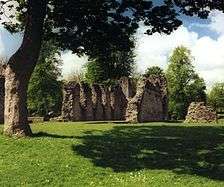Cluniac priories in Britain

In the Middle Ages, from the 11th century, the Christian Cluniac order established a number of religious houses in the kingdoms of England and Scotland.
History
Traditionally the Rule of Saint Benedict was interpreted that each monastery should be independent of other houses; this made it problematic to achieve reform if discipline had slipped or to resist the pressure to become a part of the Feudal structure, with the office of Abbot becoming an office at the disposal of the local lord. The Cluniac reform, the first major attempt to offer an institutional response to these issues, was to subvert this by making all of the monks of the houses that were part of Cluny, being members of the Cluny Abbey, with the subordinate houses being Priories of the Abbey. Subsequent orders - such as the Carthusians - were wholly integrated as an order, and modern Benedictines are organised in families which offer mutual accountability, e.g. English Benedictine Congregation, Subiaco Cassinese Congregation.
Those houses that were larger than cells were known as priories, symbolising their subordination to the Abbey of Cluny in Burgundy. The prior of St Pancras at Lewes usually held the position of vicar-general of the Abbot of Cluny for England and Scotland. Since the head of their order was the Abbot at Cluny all members of the order in Britain were bound to cross to France to Cluny to consult or be consulted unless the Abbot chose to come to Britain. This he did five times in the 13th century, and only twice in the 14th.
In 1056, the first Cluniac nunnery was founded at Marcigny and after this other convents followed including those in the British Isles. The Cluniac nuns were always been greatly outnumbered by their male counterparts.
In England the Cluniac houses numbered thirty-five at the time of Henry VIII's Dissolution of the Monasteries in the 16th century. At that time there were also three houses in the kingdom of Scotland.
List of priories
England
- Arthington Priory, Yorkshire (nuns)
- Barnstaple Priory, Devon
- Bermondsey Abbey
- Castle Acre Priory, Norfolk
- Daventry Priory, Northamptonshire
- Delapré Abbey, Northampton (nuns)
- Derby Cluniac Priory, Derby
- Dudley Priory, Dudley, West Midlands
- Faversham Abbey, Kent - Autonomous Cluniac Abbey
- Glastonbury Abbey, Somerset - Autonomous Cluniac Abbey between 1120-1170 under Abbot Henry of Blois, Bishop of Winchester
- Lenton Priory, Nottingham
- Monkton Farleigh Priory, Wiltshire
- Montacute Priory, Somerset
- Pontefract Priory, Yorkshire
- Prittlewell Priory, Essex
- Reading Abbey, Berkshire - Autonomous Cluniac Abbey
- St Andrews Abbey, Northampton
- St Pancras Priory, Lewes, Sussex
- Stansgate Priory, Essex
- Thetford Priory, Norfolk
- Wangford Priory, Suffolk
- Wenlock Priory, Shropshire
Scotland
- Crossraguel Abbey, Ayrshire
- Paisley Abbey, Renfrewshire
- Renfrew Abbey, Renfrewshire
The Cluniac Prayer
"O God, by whose grace thy servants, the Holy Abbots of Cluny, enkindled with the fire of thy love, became burning and shining lights in thy Church: Grant that we also may be aflame with the spirit of love and discipline, and may ever walk before thee as children of light; through Jesus Christ our Lord, who with thee, in the unity of the Holy Spirit, liveth and reigneth, one God, now and for ever."